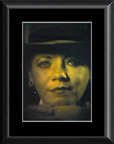A conventional image, for example a printed photograph, has only two dimensions. It is a representation of a three-dimensional subject in the real world transferred to a piece of photographic paper. The paper is flat - it has only width and height. It has no depth. Indeed part of the art of conventional photography is to convey to the observer the impression of depth in a two-dimensional image. This is typically done by using tonal gradation to indicate a surface turning away from the camera and hence reflecting less light back to the lens. The impression of depth may also be conveyed by perspective and the relative size of objects seen in an image. However, these techniques merely produce clues which help the eye and brain to relate the two-dimensional image to the three dimensions of the real world.
 |
| Image by kind permission of Frank de Freitas |
A hologram is a three-dimensional image. It actually exists in all three dimensions and the depth of an holographic image can be seen in addition to its width and depth. An observer standing in front of a real house will see the front wall and perhaps a little of one side. Moving to one side will reveal more of the side of the building and eventually perhaps even some of the back garden. The same is true when observing a hologram of a house. An observer who moves to one side will see more of the side of the house and perhaps even an element of the back garden. However, an observer viewing a two-dimensional printed photograph of the same house cannot see more by moving to one side simply because the information provided by a third dimension is not present in the image. When seen from one side, the photograph of the house appears unchanged. This computer monitor is also provides a two-dimensional image - it has only width and height.
The experience of observing some types of holograms is so real that it is like seeing the actual subject of the image. Some people want to reach out and touch the subject but of course their hand just passes through the image as it would through thin air.






